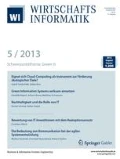Abstract
In the course of increasing customer orientation in the IT sector, IT service management becomes more important. Especially the de facto standard ITIL receives attention of IT management at present. Deficits of the ITIL reference model are often ignored, benefits are only assumed and a lot of misunderstandings exist. Uncertainties, unfulfilled expectations and problems during the accomplishment of ITIL projects are the result. In this context the paper deals with a critical analysis of the ITIL reference model. It fulfils a formal evaluation of the model on the basis of established criteria. On the basis of this evaluation implications for IT management are derived. Findings are derived from four case studies as well as an in-depth analysis of the ITIL documentation itself.
Similar content being viewed by others
Literatur
Batini, C.; Ceri, S.; Navathe, S. B.: Conceptual Database Design — An Entity-Relationship-Approach. Benjamin Cummings, Redwood City 1992.
Becker, J.; Knackstedt, R.; Holten, R.; Hansmann, H.; Neumann, S.: Konstruktion von Methodiken: Vorschläge für eine begriffliche Grundlegung und domänenspezifische Anwendungsbeispiele. Institut für Wirschaftsinformatik, Univerität Münster, Münster 2001.
Becker, J.; Algermissen, L.; Delfmann, P.; Knackstedt, R.: Referenzmodellierung. In: Das Wirtschaftsstudium (WISU) 31 (2002) 11, S. 1392–1395.
Bernhard, M.: Die IT und ihre neue Kernkompetenz — Vom Verwalter zum service-orientierten Dienstleister. In: Bernhard, M.; Lewandowski, W.; Mann, H. (Hrsg.): Service-Level-Management in der IT. Symposion Publishing, Düsseldorf 2000, S. 253–262.
Becker, J.; Rosemann, M.; Schütte, R.: Grundsätze ordnungsmäßiger Modellierung. In: Wirtschaftsinformatik 37 (1995) 3, S. 309–316.
British Standard Institute: BS 15000: 2000 Specification for IT Service Management. The Stationary Office, London 2000.
Doughty, K.: A Framework for Incident and Change Management. In: Enterprise Operations Management 27 (2003) 6, S. 1–11.
EXIN: Examen ITIL Foundation. 2003, http://www.exin.nl/pdfout/2004020509463482821521.pdf, Abruf am 2004-02-05.
Frank, U.: Zur Verwendung formaler Sprachen in der Wirtschaftsinformatik: Notwendiges Merkmal eines wissenschaftlichen Anspruchs oder Ausdruck eines übertriebenen Szientismus? In: Becker, J.; König, W.; Schütte, R.; Wendt, O.; Zelewski, S. (Hrsg.): Wirtschaftsinformatik und Wissenschaftstheorie: Bestandsaufnahme und Perspektiven. Gabler, Wiesbaden 1999.
Hendriks, L.; Carr, M.: ITIL: best practice in IT Service Management. In: van Bon, J.: The guide to IT Service Management. Volume 1, Addison-Wesley, London 2002, S. 131–150.
Holst, H.; Holst, J.: IT-Produkt- und Klientenmanagement. In: Information Management 13 (1998) 2, S. 56–65.
Hochstein, A.; Hunziker, A.: Serviceorientierte Referenzmodelle des IT-Managements. In: HMD — Praxis der Wirtschaftsinformatik 40 (2003) 232, S. 45–56.
Holl, A.: Empirische Wirtschaftsinformatik und Erkenntnistheorie. In: Becker, J.; König, W.; Schütte, R.; Wendt, O.; Zelewski, S. (Hrsg.): Wirtschaftsinformatik und Wissenschaftstheorie: Bestandsaufnahme und Perspektiven. Gabler, Wiesbaden 1999.
Holzmüller, H.; Lammerts, A.; Stolper, M.: Studie: ITIL — Status und Trends in Deutschland. 2003, http://www.it-surveys.de/itsurvey/its-b.html, Abruf am 2004-01-30.
IT Service Management Forum: What is the itSMF? http://www.itsmf.com/about/whatis.asp, Abruf am 2004-01-29.
Keisch, C.; Pondman, D.; Kemmerling, G.; van Bon, J.: IT Service Management. Eine Einführung. Van Haren Publishing, Zaltbommel 2002.
Kern, G. M.: A Framework for Service Management of Information Systems. In: Mid American journal of business 13 (1998) 1, S. 49–57.
Krogstie, J.; Lindland, O. I., Sindre, G.: Defining Quality Aspects for Conceptual Models. In: Proc. of the International Conference on Information System Concepts (ISCO3). Marburg 1995.
Lawes, A.: ITIL & itSMF — next Steps in the global success story. In: Proc. 1. Tagung SwissICT und itSMF — IT Service Management, Zürich 22. Oktober 2003.
Lacity, M.; Willocks, L.: Global Information Technology Outsourcing: In Search of Business Advantage. John Wiley & Sons, Chichester 2001, S. 1–39.
Macfarlane, I.; Rudd, C.: IT Service Management. The Stationary Office, London 2002.
Matlus, R.; Scardino, L.: Successful Outsourcing Means Retaining Some Staff. Gartner 2002.
Moody, D. L.; Shanks, G. G.: What makes a good data model? A Framework for Evaluating and Improving the Quality of Entity Relationship Models. In: Australian Computer Journal 30 (1998) 3, S. 97–110.
Office of Government Commerce: IT Infrastructure Library. The Stationary Office, London 2000.
Office of Government Commerce: Service Support. The Stationary Office, London 2000.
Office of Government Commerce: Service Delivery. The Stationary Office, London 2000.
Röwekamp, R.: ITIL Prozesse nach Plan. In: CIO 3 (2003) 9, S. 52–55.
Scardino, L.: Managing the Multisourced Environment. Gartner 2002.
Schütte, R.: Grundsätze ordnungsmäßiger Referenzmodellierung — Konstruktion konfigurations- und anpassungsorientierter Modelle, Gabler, Wiesbaden 1998.
Senger, E.; Österle, H.: PROMET BECS — A Project Method for Business Engineering Case Studies. Institut für Wirtschaftsinformatik, Universität St. Gallen, St. Gallen 2002.
Staudt, H.: ITIL vereinheitlicht IT-Service-Prozesse. In: Information Management & Consult 18 (2003) Sonderausgabe, S. 63–67.
van Bon, J.: The guide to IT Service Management. Volume 1, Addison-Wesley, London 2002.
Vogt, W.: fIT for benefit. Perseo Consult, Basel 2002.
Zarnekow, R.; Brenner, W.: Konzepte für ein produktorientiertes Informationsmanagement. In: Uhr, W.; Esswein, W.; Schoop, E. (Hrsg.): Wirtschaftsinformatik 2003/Band II: Medien, Märkte, Mobilität. Physica-Verlag, Heidelberg 2003.
Author information
Authors and Affiliations
Corresponding author
Rights and permissions
About this article
Cite this article
Hochstein, A., Zarnekow, R. & Brenner, W. ITIL als Common-Practice-Referenzmodell für das IT-Service-Management — Formale Beurteilung und Implikationen für die Praxis. Wirtschaftsinf 46, 382–389 (2004). https://doi.org/10.1007/BF03250951
Published:
Issue Date:
DOI: https://doi.org/10.1007/BF03250951




